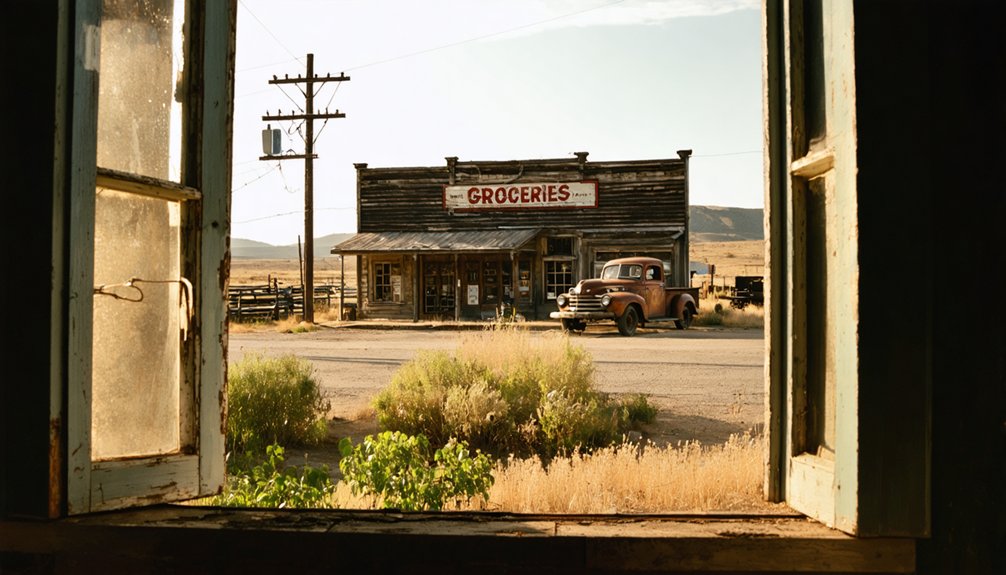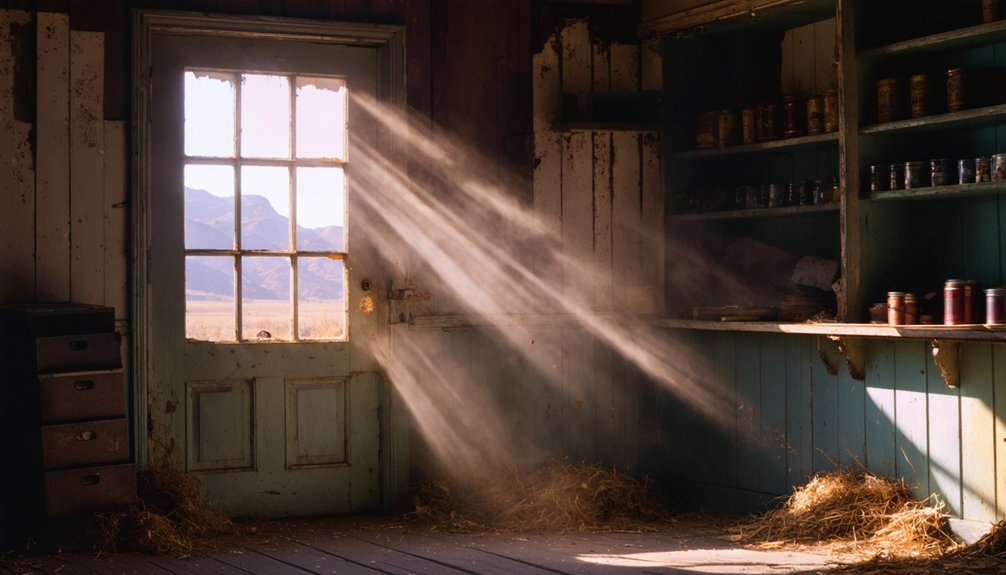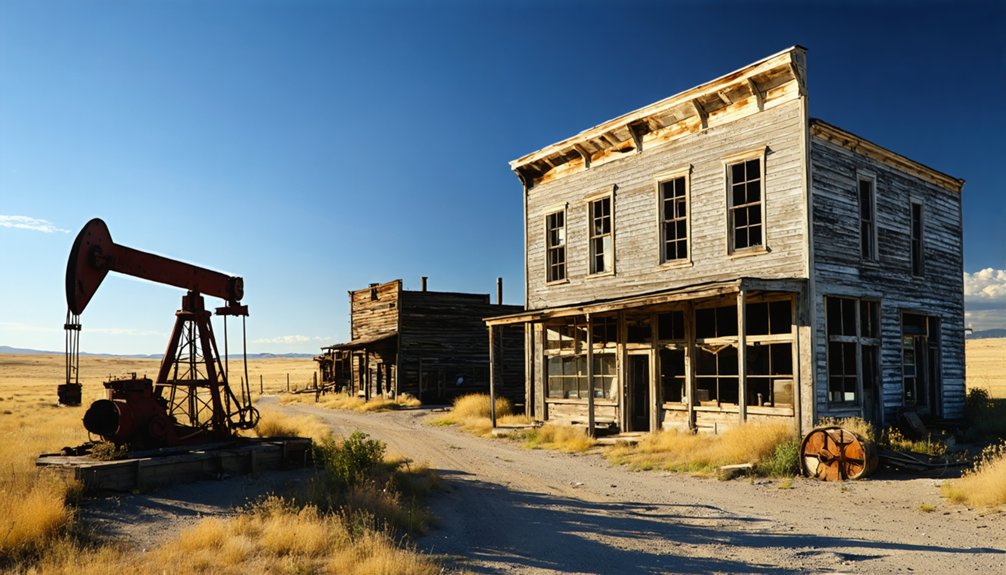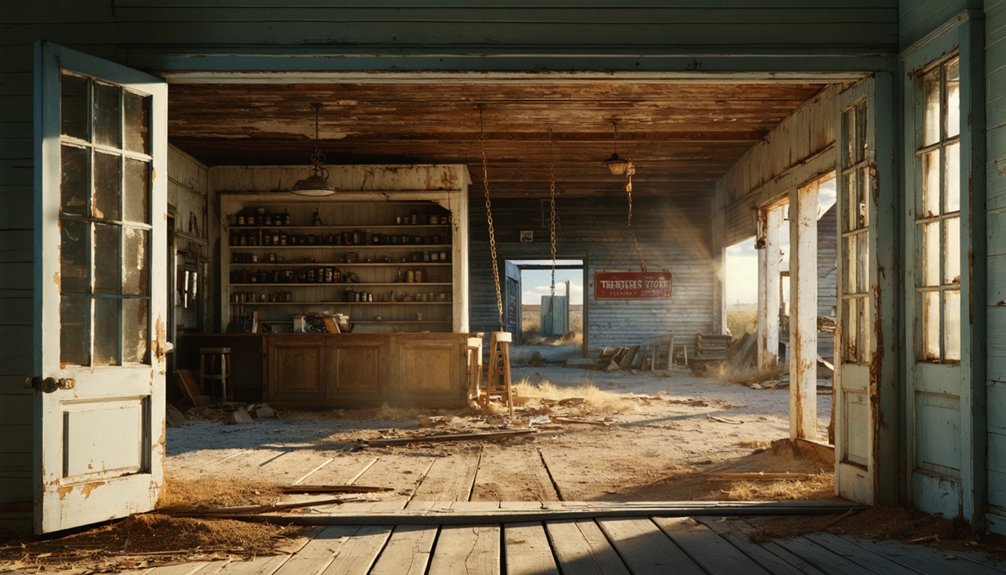You’ll find the ghost town of Lookout perched at 5,220 feet in South Dakota’s Black Hills, where gold fever sparked its birth in 1874. The town quickly grew to 600 residents, thriving on mining and lumber operations centered around Lookout Mine and its sawmill. While the boom lasted through the 1880s, economic struggles led to its abandonment by 1905. Today, only scattered foundations and tramway remnants hint at deeper stories buried in this mountain settlement’s past.
Key Takeaways
- Lookout was a Black Hills mining boomtown established in 1874, reaching its peak population of 600 residents by 1884.
- Located at 5,220 feet elevation in Pennington County, the town centered around gold mining operations and lumber production.
- The town featured an elevated tramway system for transporting ore, along with sawmills and social establishments like saloons.
- Mining operations ceased in 1905, leading to the town’s abandonment and transformation into a ghost town.
- Today, only foundations and rubble remain of the original structures, with no formal preservation efforts protecting the site.
The Rise of a Mining Boomtown
As the Black Hills gold rush gained momentum in 1874, Lookout emerged as one of several promising mining settlements in Dakota Territory.
You’d find this bustling community perched at 5,220 feet elevation in Pennington County, where mining rivalries drove rapid development. By 1884, you could’ve counted around 600 residents, most working at either the Lookout Mine, its sawmill, or the nearby Spread Eagle Mine.
The town’s growth centered on its sophisticated mining operation, featuring an elevated tramway that transported ore from Lookout Mountain to the mill facilities along Castle Creek.
Early prospectors at the site discovered minimal gold yields, similar to the disappointing initial findings at French Creek that had prompted miners to seek better locations.
What’s now a ghost town once hummed with the activity of hard-rock mining, evolving from earlier placer techniques as miners discovered that most gold was locked within quartz deposits.
The settlement’s development followed the pattern of other Black Hills communities that emerged after the Custer Expedition discovered gold in the region.
Life in 1880s Lookout
Three distinct social spheres shaped daily life in 1880s Lookout: the mines, the sawmill, and the saloons. You’d have found around 600 residents, mostly mine workers and sawmill employees, living in modest housing near these bustling operations.
The town’s cultural diversity reflected the era’s mining camps, with immigrants joining the workforce and bringing their traditions to community gatherings. Visitors could enjoy fresh sarsaparilla at Longhorn, providing an authentic taste of the Old West. Many residents hosted Gaslight Restaurant style meetups to maintain community bonds.
Mining camps drew workers from across the globe, weaving a tapestry of cultures into daily frontier life.
Life wasn’t easy – you’d have faced harsh winters, dusty conditions, and basic amenities.
At night, you’d likely have joined others at the saloons, which served as the town’s primary entertainment venues. These establishments offered gambling, dancing, and a chance to unwind after long days of physical labor.
The community’s prosperity ebbed and flowed with mining yields, creating a dynamic but uncertain lifestyle typical of frontier settlements.
Mining Operations and Economic Growth
During the 1880s, you’d find Lookout’s mining operations at their peak, employing around 600 workers across various extraction sites and processing facilities.
You could see the elevated tramway system transporting ore from the mountainside down to the prominent mill on Castle Creek, where workers processed gold and silver using free milling techniques.
The operation’s success relied on surface mining methods, with some shaft mining for feldspar extraction, while the mill’s efficient processing capabilities helped sustain the town’s economic growth throughout the decade.
Located at 5,220 feet elevation, the mine’s position in the Black Hills provided strategic advantages for mineral extraction.
Peak Production Years
The Black Hills gold rush reached its zenith between 1876 and 1877, transforming Lookout and surrounding areas into bustling mining centers.
During this peak mining period, you’d have witnessed thousands of prospectors flooding into the region, drawn by rich placer gold discoveries along creeks like Deadwood. The rush quickly evolved into sophisticated hard-rock mining operations, with the nearby Homestake Mine becoming one of the world’s most productive gold sources.
While Lookout’s specific production peaks aren’t documented, it operated during this prosperous era, extracting both gold and silver. Today, the Wharf Mine remains the only active large-scale gold mine still operating in South Dakota.
The boom didn’t just create temporary camps – it established lasting infrastructure and communities. Though Lookout would eventually become a ghost town, the Black Hills region maintained impressive production levels through the mid-20th century, helping South Dakota rank third nationally in gold output by 1965.
Mining Equipment and Techniques
When miners first arrived at Lookout in the 1870s, they relied on basic placer mining techniques to extract gold from stream gravels, but operations quickly evolved to include sophisticated equipment and methods.
By 1876, the Jones and Pinney Mill introduced stamp mills for crushing ore, marking a shift toward mechanized mining machinery. The area’s mining activities paralleled those at the Homestake Mine claim, which became the region’s richest gold source.
You’ll find that Lookout’s mining operations embraced several key extraction techniques as technology advanced. They installed elevated tramways to transport ore to the mills on Castle Creek, and by 1900, they’d added pneumatic drills to boost productivity in hard rock mining.
The introduction of cyanide processing proved particularly revolutionary, allowing miners to recover more gold from lower-grade ore that was previously unprofitable.
These technological improvements helped sustain Lookout’s mining operations well into the early 20th century.
The Lumber Industry’s Role
Shortly after settlers arrived in 1874, lumber operations sprang up across the Black Hills to harvest the abundant Yellow Ponderosa pine. John Frances Murphy established the first sawmill in nearby Custer in 1876, setting off a wave of lumber development that would transform the region.
You’ll find the industry’s impact was particularly visible in Lookout, where specialized logging techniques evolved to handle the challenging terrain. By 1900, the area became part of a booming timber sector with twelve sawmills in Custer.
Lumber transportation became increasingly sophisticated, with Shay and Heisler geared locomotives tackling steep grades up to 28%. The timber directly supported Lookout’s mining operations, providing critical underground bracing and infrastructure. The region’s timber practices were shaped by Gifford Pinchot’s policies, which established sustainable forestry standards for the newly created Forest Reserves.
Local sawmills, like the one on Castle Creek, connected to the mines via tramways, while larger companies like Homestake Mining Company operated their own extensive logging operations to feed the constant demand for wood.
Daily Life and Community Spirit

Life in Lookout centered around its bustling workforce of 600 residents during the town’s peak in 1884. You’d find most folks working hard at the sawmill or in the Lookout and Spread Eagle mines, coming together at day’s end to support one another through the challenges of frontier life.
The town’s social resilience shone through its community gatherings at local schools, churches, and town events. You could count on your neighbors during harsh winters or economic downturns, as mutual aid became a cornerstone of survival. Like many small towns of the era, the harsh winter conditions drove away numerous homesteaders seeking better opportunities elsewhere.
Workers forged strong bonds through their shared experiences at the mines and sawmill, creating a tight-knit atmosphere typical of South Dakota frontier towns. Despite the eventual decline of mining operations, this spirit of solidarity remained a defining feature of Lookout’s character.
The Decline and Abandonment
The vibrant spirit of Lookout began to fade as the 1890s approached, marking the beginning of the town’s steady decline.
When the governor of New Hampshire and his associates took control of the mill and property in 1890, the community’s dynamic shifted dramatically. Economic challenges soon followed, leading to a gradual exodus of residents from the once-thriving mining town.
You can trace the community decline through the dwindling mining operations, which finally ceased in 1905.
The town that once bustled with 600 residents in 1884 slowly emptied, leaving behind only silent remnants of its prosperous past.
Today, you’ll find the weathered ruins of the mill, tramway, and flume as evidence to Lookout’s mining heritage, all easily accessible via a 2WD road along Castle Creek.
Exploring the Ghost Town Today

Visiting Lookout’s ghost town today requires careful planning and respect for private property boundaries. You’ll likely encounter minimal remaining structures, with foundations and rubble being the primary physical evidence of the former settlement.
Ghost town exploration here offers a quiet, isolated atmosphere typical of abandoned South Dakota towns.
Before your visit, check satellite imagery to pinpoint exact locations, as documentation is sparse. You’ll need to navigate unpaved roads and prepare for no amenities or services on-site.
Visitor safety is essential – watch for unstable structures and wildlife while exploring. Bring your camera to capture the eerie atmosphere and nature’s reclamation of the site.
Remember that most ghost towns in this region are on private land, so always honor no trespassing signs and obtain necessary permissions.
Preserving Lookout’s Legacy
Despite its historical significance as a Black Hills mining settlement, Lookout’s remaining physical heritage faces mounting preservation challenges.
You’ll find the mill ruins, tramway remnants, and flume traces slowly succumbing to natural decay and erosion, with no formal protection or conservation efforts in place.
While South Dakota’s State Historic Preservation Office actively supports many historical sites, Lookout hasn’t received official recognition or protection status.
You won’t find interpretive signs, guided tours, or community involvement that could help safeguard these important ruins.
The site’s accessibility by road makes it vulnerable to vandalism and unmanaged visitor impact.
Without preservation strategies or local initiatives, Lookout’s physical connection to the region’s mining era continues to fade, highlighting the urgent need for conservation action.
Historical Impact on Black Hills Development

While prospectors had long suspected gold in the Black Hills, its discovery on Montezuma Hill in August 1876 catalyzed Lookout’s pivotal role in the region’s development.
Within months, hundreds of miners and their families transformed the untamed landscape into a bustling hub of activity, complete with mills, hoists, and an innovative ore tramway system.
Pioneering settlers rapidly transformed raw wilderness into an industrial marvel, building the infrastructure that would define Lookout’s mining legacy.
You’ll find that Lookout’s influence extended beyond mere economic gains. The town became a melting pot of cultural exchange as immigrants and migrants brought diverse traditions and skills.
The rapid development of roads and infrastructure connected previously isolated areas, while mining operations left an environmental impact that’s still visible today.
Through boom-and-bust cycles, Lookout exemplified the dynamic forces that shaped the Black Hills’ evolution from frontier territory to settled region.
Frequently Asked Questions
Are There Any Reported Paranormal Activities or Ghost Sightings in Lookout?
You won’t find documented ghost stories or local legends from Lookout. While other Black Hills ghost towns have paranormal claims, there’s no verified evidence of supernatural activity at this former mining town.
What Happened to the Families Who Lived in Lookout After Abandonment?
You’ll find most families relocated to nearby towns like Deadwood and Lead, seeking work after economic decline forced them out. They left their family legacies behind, adapting to new lives elsewhere.
Can Visitors Legally Collect Artifacts From the Lookout Ghost Town?
You can’t legally collect artifacts without proper permits, as both federal and state legal regulations protect ghost town sites. Instead, support artifact preservation by photographing items and reporting discoveries to authorities.
Does Anyone Still Own Property or Maintain Residences in Lookout?
You’ll find no active residents or regular property maintenance today, though there might be occasional private owners or caretakers who sporadically check abandoned structures, similar to other South Dakota ghost towns.
What Safety Precautions Should Explorers Take When Visiting Lookout’s Mine Sites?
Don’t enter mine shafts – they’re deadly dangerous. Bring explorer gear including satellite phone, first-aid kit, sturdy boots, and protective clothing. Always inform others of your plans before visiting mine sites.
References
- https://www.youtube.com/watch?v=_0WNYsFLSLA
- https://www.sdhspress.com/journal/south-dakota-history-2-2/some-black-hills-ghost-towns-and-their-origins/vol-02-no-2-some-black-hills-ghost-towns-and-their-origins.pdf
- https://www.sdpb.org/rural-life-and-history/2023-08-21/some-black-hills-ghost-towns-and-their-origins
- https://www.southdakotamagazine.com/one-man-towns
- https://photobyjohnbo.com/2021/01/26/okaton-south-dakota/
- https://www.onlyinyourstate.com/experiences/south-dakota/scenic-abandoned-town-sd
- https://www.ghosttowns.com/states/sd/lookout.html
- https://en.wikipedia.org/wiki/List_of_ghost_towns_in_South_Dakota
- https://www.blackhillsbadlands.com/blog/post/old-west-legends-mines-ghost-towns-route-reimagined/
- https://history.sd.gov/docs/Mining.pdf



